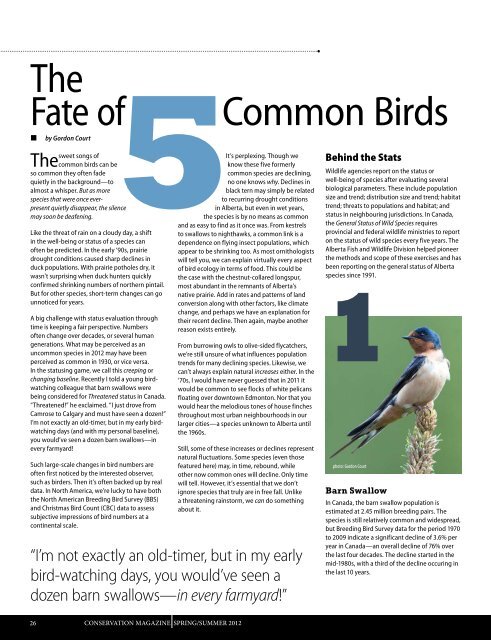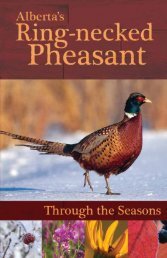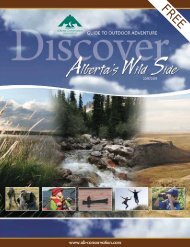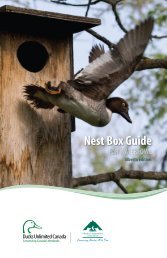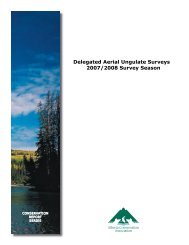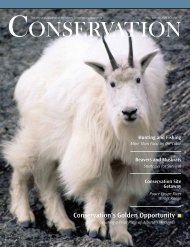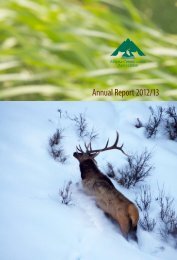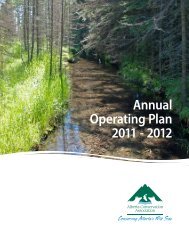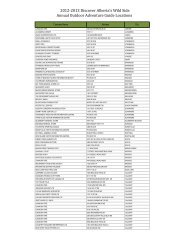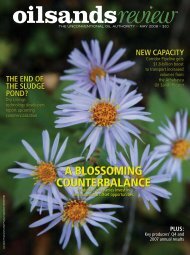Download Magazine PDF - Alberta Conservation Association
Download Magazine PDF - Alberta Conservation Association
Download Magazine PDF - Alberta Conservation Association
You also want an ePaper? Increase the reach of your titles
YUMPU automatically turns print PDFs into web optimized ePapers that Google loves.
TheFate of• by Gordon Courtsweet songs ofThe common birds can beso common they often fadequietly in the background—toalmost a whisper. But as morespecies that were once everpresentquietly disappear, the silencemay soon be deafening.Like the threat of rain on a cloudy day, a shiftin the well-being or status of a species canoften be predicted. In the early ‘90s, prairiedrought conditions caused sharp declines induck populations. With prairie potholes dry, itwasn’t surprising when duck hunters quicklyconfirmed shrinking numbers of northern pintail.But for other species, short-term changes can gounnoticed for years.A big challenge with status evaluation throughtime is keeping a fair perspective. Numbersoften change over decades, or several humangenerations. What may be perceived as anuncommon species in 2012 may have beenperceived as common in 1930, or vice versa.In the statusing game, we call this creeping orchanging baseline. Recently I told a young birdwatchingcolleague that barn swallows werebeing considered for Threatened status in Canada.“Threatened!” he exclaimed. “I just drove fromCamrose to Calgary and must have seen a dozen!”I’m not exactly an old-timer, but in my early birdwatchingdays (and with my personal baseline),you would’ve seen a dozen barn swallows—inevery farmyard!Such large-scale changes in bird numbers areoften first noticed by the interested observer,such as birders. Then it’s often backed up by realdata. In North America, we’re lucky to have boththe North American Breeding Bird Survey (BBS)and Christmas Bird Count (CBC) data to assesssubjective impressions of bird numbers at acontinental scale.“I’m not exactly an old-timer, but in my earlybird-watching days, you would’ve seen adozen barn swallows—in every farmyard!”Going UnnoticedCommon BirdsIt’s perplexing. Though weknow these five formerlycommon species are declining,no one knows why. Declines inblack tern may simply be relatedto recurring drought conditionsin <strong>Alberta</strong>, but even in wet years,the species is by no means as commonand as easy to find as it once was. From kestrelsto swallows to nighthawks, a common link is adependence on flying insect populations, whichappear to be shrinking too. As most ornithologistswill tell you, we can explain virtually every aspectof bird ecology in terms of food. This could bethe case with the chestnut-collared longspur,most abundant in the remnants of <strong>Alberta</strong>’snative prairie. Add in rates and patterns of landconversion along with other factors, like climatechange, and perhaps we have an explanation fortheir recent decline. Then again, maybe anotherreason exists entirely.From burrowing owls to olive-sided flycatchers,we’re still unsure of what influences populationtrends for many declining species. Likewise, wecan’t always explain natural increases either. In the‘70s, I would have never guessed that in 2011 itwould be common to see flocks of white pelicansfloating over downtown Edmonton. Nor that youwould hear the melodious tones of house finchesthroughout most urban neighbourhoods in ourlarger cities—a species unknown to <strong>Alberta</strong> untilthe 1960s.Still, some of these increases or declines representnatural fluctuations. Some species (even thosefeatured here) may, in time, rebound, whileother now common ones will decline. Only timewill tell. However, it’s essential that we don’tignore species that truly are in free fall. Unlikea threatening rainstorm, we can do somethingabout it.Behind the StatsWildlife agencies report on the status orwell-being of species after evaluating severalbiological parameters. These include populationsize and trend; distribution size and trend; habitattrend; threats to populations and habitat; andstatus in neighbouring jurisdictions. In Canada,the General Status of Wild Species requiresprovincial and federal wildlife ministries to reporton the status of wild species every five years. The<strong>Alberta</strong> Fish and Wildlife Division helped pioneerthe methods and scope of these exercises and hasbeen reporting on the general status of <strong>Alberta</strong>species since 1991.1photo: Gordon CourtBarn SwallowIn Canada, the barn swallow population isestimated at 2.45 million breeding pairs. Thespecies is still relatively common and widespread,but Breeding Bird Survey data for the period 1970to 2009 indicate a significant decline of 3.6% peryear in Canada—an overall decline of 76% overthe last four decades. The decline started in themid-1980s, with a third of the decline occuring inthe last 10 years.3photo: Gordon Court4Common Nighthawk2photo: Gordon CourtCommon nighthawks in Canada areestimated at 400,000 breeding adults.However, Breeding Bird Survey datareveal a significant long-term declineof 4.2% per year between 1968 and2009. From 1995 to 2005, the measureddecline peaked at 6.6% per year—a49.5% population decrease during thatperiod. Declines have been observedalong Breeding Bird Survey routes in bothsouthern Canada and throughout theboreal forest, indicating that populationissues are not restricted to the morepopulated portions of the country. Thisspecies is listed as Threatened by theCommittee on the Status of EndangeredWildlife in Canada (COSEWIC).5Recognized as North America’s most commonfalcon, the pretty American kestrel is decliningthroughout the continent. In <strong>Alberta</strong>, the specieswas once one of the most common raptors inthe Parkland and Prairie eco-regions, but is nowdifficult to find during breeding season (May toAugust) in those areas. The bird is still relativelycommon in the boreal forest, especially inburned areas. Breeding Bird Survey trend datafor southern Canada show a decline of 3.2% peryear between 1984 and 2009, correspondingto about a 70% population decrease over thatperiod. The declines pre-date West Nile Virusepidemics in North American birds and no othercompelling explanations exist for the loss.American KestrelBlack TernThis elegant, wetland-dependent bird is decliningthroughout North America, in areas hit by droughtand in places where wetlands are in good shape.In <strong>Alberta</strong>, the species declined by about 4.1% peryear from 1986 to 2009, so our population is aboutone-third of what it was in the mid-1980s. Certainly,drought and wetland drainage have contributedto this species dwindling in the more settled partsof the province. Researchers indicate wetland lossalong migration routes is also an issue. Additionally,agricultural insect control and overfishing mayhave diminished food supplies in the black tern’swintering range.photo: Brad DowneyDr. Gordon Court is a frequent contributor to <strong>Conservation</strong> <strong>Magazine</strong>. He is the Provincial Wildlife Status Biologist for the <strong>Alberta</strong> Fish andWildlife Division, ASRD. As such, Gordon is directly involved in the General Status of Wild Species program, both provincially and nationally,sits as the <strong>Alberta</strong> Scientific Authority for the Convention on Trade in Endangered Species (CITES), and is the voting member for <strong>Alberta</strong> on theCommittee on the Status of Endangered Wildlife in Canada (COSEWIC).photo: Gordon CourtChestnut-collared LongspurDid you know a quarter of the world’s chestnut–collared longspur population occurs here?That leaves Canada with a significant globalresponsibility. The Canadian population isestimated at 600,000—still a relatively commonbird. However, long-term analyses using datafrom Breeding Bird Surveys (1968–2008) andChristmas Bird Counts (1967–2008) documentpopulation declines of 90% and 93%, respectively.Shorter survey intervals indicate populationlosses ranging from 35% to 63% over the last 10years (Grassland Bird Monitoring program). nWhat You Can DoLearn as you go.Get to know your wild neighbours and encourage othersto do the same. All you need is a field guide to learnthe names of the animals and plants in the province.Wildlife viewing and birding is one of the fastest growingpastimes in North America—join in!Count yourself in.Participate in Christmas Bird Counts in your area orjoin an annual Breeding Bird Survey. Put your wildlifeidentification skills to use and help improve databasesthat evaluate trends in bird populations.Get behind a cause.Support conservation organizations that work to protectimportant natural habitats, especially those underconstant threat, such as native grasslands or wetlands.Just go!Visit conservation areas and enjoy <strong>Alberta</strong>’s spectacularnatural heritage. Bring your friends and tell others aboutyour adventures!Hang on to habitat.Recycle (especially paper and cardboard) and encourageothers to do the same. Trees, especially in mature forests,are essential habitat for many birds breeding in <strong>Alberta</strong>.WILD ON THE WEBab-conservation.com/unnoticedWatch black terns nesting, incubating eggs and feedingdragonfly larvae to their young chick.26 CONSERVATION MAGAZINE SPRING/SUMMER 2012CONSERVATION MAGAZINE SPRING/SUMMER 201227


